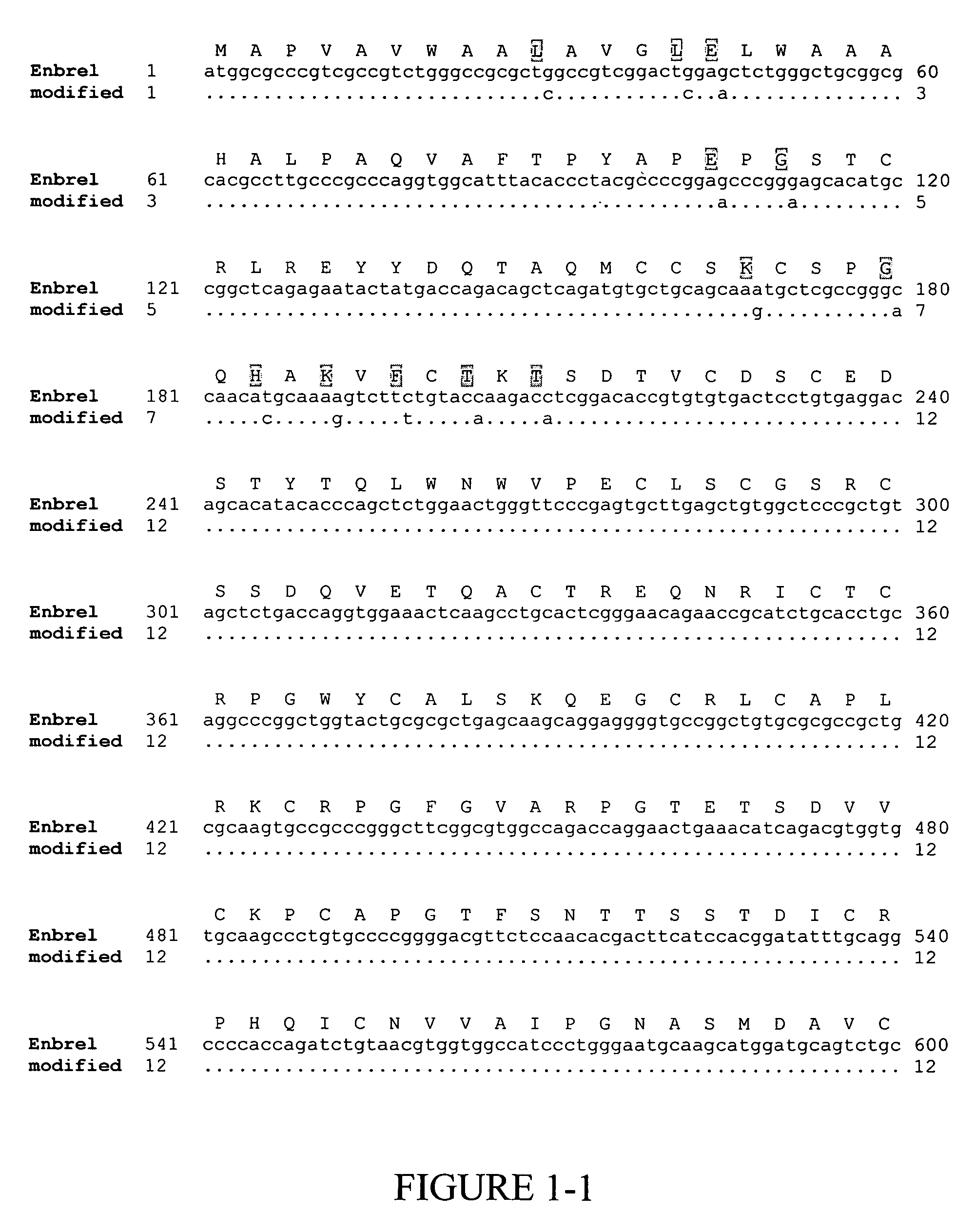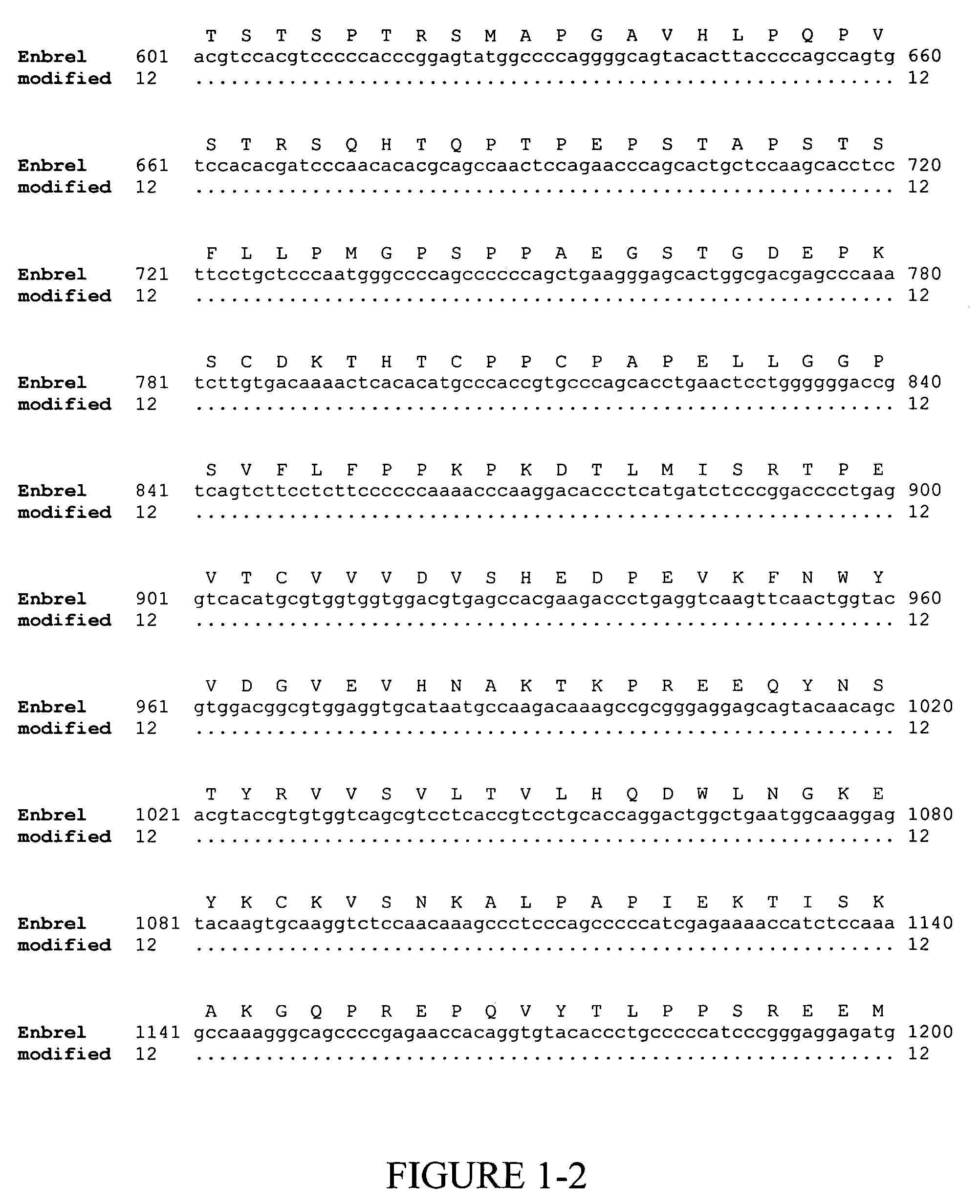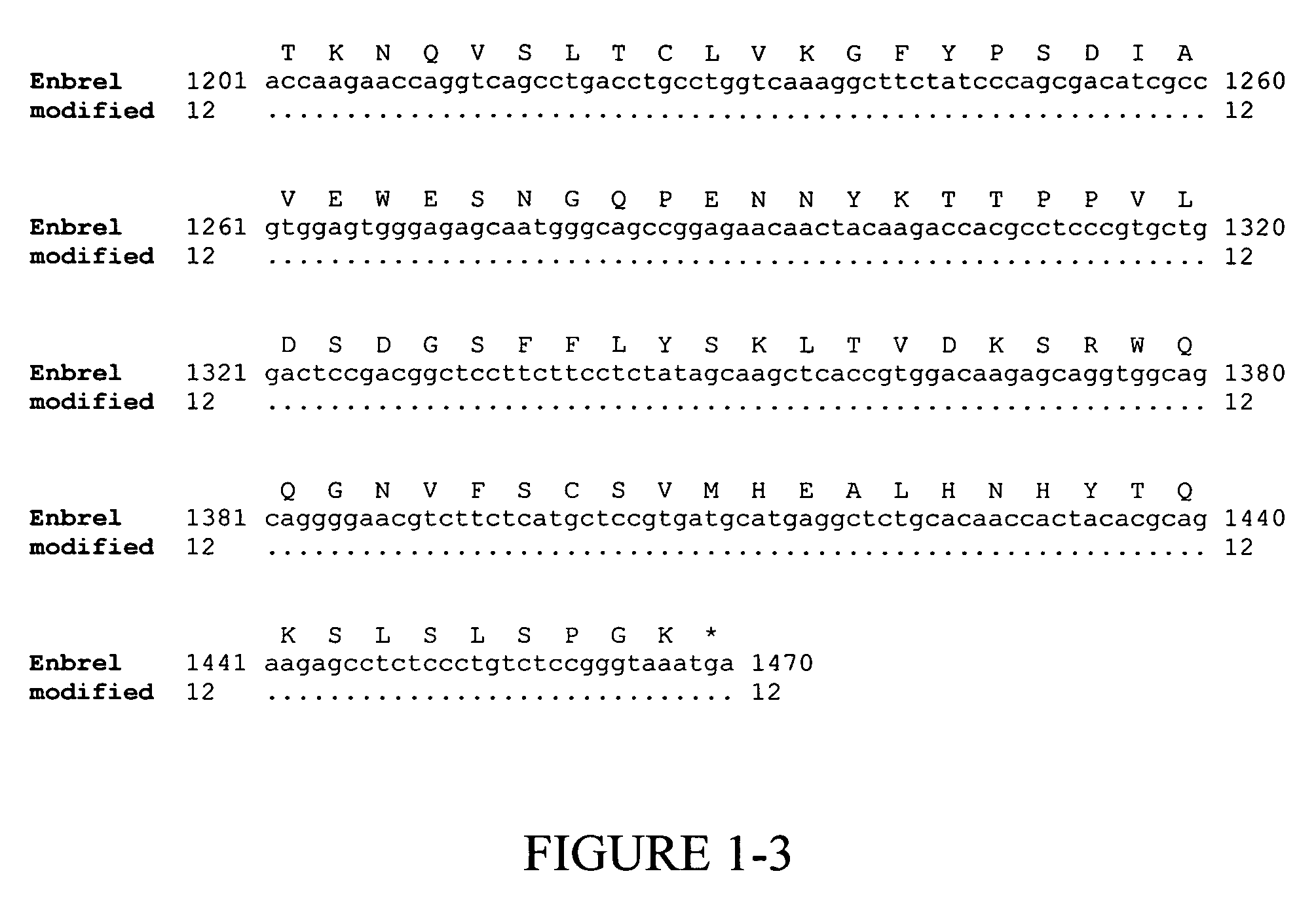Gene expression system based on codon translation efficiency
a gene expression and codon technology, applied in the field of gene expression, can solve the problems of significant obstacles and lower than expected translation efficiency
- Summary
- Abstract
- Description
- Claims
- Application Information
AI Technical Summary
Benefits of technology
Problems solved by technology
Method used
Image
Examples
example 1
Construction of Codon Modified Enbrel®-encoding Polynucleotide for Enhanced Expression in CHO Cells
[0139]Enbrel® (also known as etanercept) is a recombinant fusion protein consisting of two soluble TNF receptors joined by the Fc fragment of a human IgG1 molecule, whose amino acid sequence is set forth in SEQ ID NO:2. The unmodified gene sequence is shown in SEQ ID NO:1 and several codons (CTG encoding Leu10 and Leu14; GAG encoding Glu15 and Glu35; GGG encoding Gly37; GGC encoding Gly60; AAA encoding Lys56 and Lys64; CAT encoding His62; TTC encoding Phe66; and ACC encoding Thr68 and Thr70) were identified in this sequence, which have low translational efficiencies as set forth in TABLES 1 and 2. Synonymous codons (LeuCTC, GluGAA, GlyGGA, LysAAG, HisCAC, PheTTT and ThrACA) with higher translational efficiencies were then chosen for replacing the low translationally efficient codons. For convenience, these replacements are shown in FIG. 1, which depicts a comparison of the modified and...
example 2
Construction of Codon Modified HPV16E7-encoding Polynucleotide for Enhanced Expression in CHO Cells
[0143]The wild-type coding sequence of HPV16E7 is shown in SEQ ID NO:4 and several codons (CAT encoding His2, His9 and His51; CCT encoding Pro6; CCA encoding Pro17, and Pro98; CCG encoding Pro47; TTG encoding Leu8, Leu15, Leu67 and Leu79; TTA encoding Leu13, Leu28 and Leu83; CTT encoding Leu65; CTG encoding Leu82; CTA encoding Leu87; GAG encoding Glu18, Glu26, Glu33, Glu34 and Glu35; ACT encoding Thr20 and Thr78; ACC encoding Thr56; TGT encoding Cys24, Cys58, Cys61 and Cys94; AAT encoding Asn29 and Asn53; GAC encoding Asp30, Asp48, Asp62, Asp75 and Asp81; TCA encoding Ser32; GCT encoding Ala42; GCC encoding Ala50; GGC encoding Gly85; and AAA encoding Lys97) were identified in this sequence, which have low translational efficiencies as set forth in TABLES 1 and 4. Synonymous codons (HisCAC, ProCCC, LeuCTC, GluGAA, CysTGC, AsnAAC, AspGAT, SerTCT, AlaGCA, ThrACA, GlyGGA and LysAAG) with h...
example 3
Construction of Codon Modified Human Growth Hormone cDNA for Enhanced Expression in CHO Cells
[0145]The wild-type coding sequence of human growth hormone (hGH) is shown in SEQ ID NO:7 and several codons (GCT encoding Ala2, Ala12 and Ala29; GCC encoding Ala26, Ala43, Ala50 and Ala60; ACA encoding Thr3; ACC encoding Thr29 and Thr53; GGC encoding Gly4, Gly14 and Gly24; TCC encoding Ser5, Ser8 and Ser33; AGT encoding Ser25; TCA encoding Ser69; CTG encoding Leu9, Leu11, Leu15, Leu18, Leu46 and Leu49; CTT encoding Leu21; TTA encoding Leu32; GAG encoding Glu23 and Glu56; TTC encoding Phe27 and Phe70; CCA encoding Pro28 and Pro63; CCT encoding Pro35; AGG encoding Arg34; CGC encoding Arg42; GAC encoding Asp37; and CAT encoding His44) were identified in this sequence, which have low translational efficiencies as set forth in TABLES 1 and 2. Synonymous codons (AlaGCA, GlyGGA, SerTCT, LeuCTC, GluGAA, PheTTT, ProCCC, ThrACA, ArgAGA, HisCAC and AspGAT) with higher translational efficiencies were t...
PUM
| Property | Measurement | Unit |
|---|---|---|
| total volume | aaaaa | aaaaa |
| temperature | aaaaa | aaaaa |
| temperature | aaaaa | aaaaa |
Abstract
Description
Claims
Application Information
 Login to View More
Login to View More - R&D
- Intellectual Property
- Life Sciences
- Materials
- Tech Scout
- Unparalleled Data Quality
- Higher Quality Content
- 60% Fewer Hallucinations
Browse by: Latest US Patents, China's latest patents, Technical Efficacy Thesaurus, Application Domain, Technology Topic, Popular Technical Reports.
© 2025 PatSnap. All rights reserved.Legal|Privacy policy|Modern Slavery Act Transparency Statement|Sitemap|About US| Contact US: help@patsnap.com



